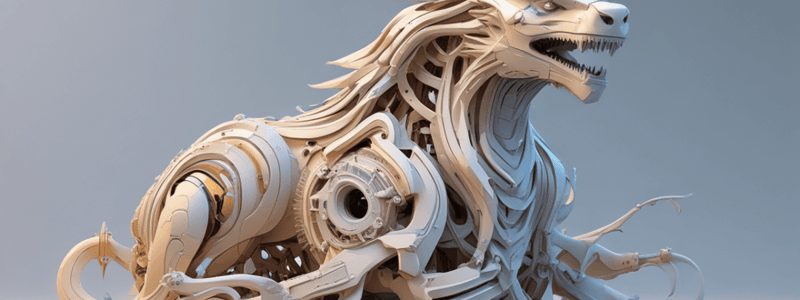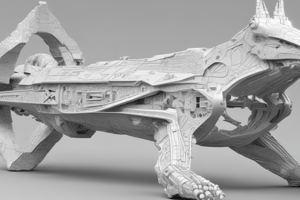Podcast
Questions and Answers
What is the primary driver of a country's economy according to the introduction?
What is the primary driver of a country's economy according to the introduction?
- The ability to respond quickly to changing customer demands
- The reduction of production costs
- The utilization of new innovative technologies
- Development of new products with shorter development time (correct)
What is the primary characteristic of a prototype?
What is the primary characteristic of a prototype?
- It is a model from which further models and eventually the final product will be derived (correct)
- It is a model that can only be made from metals
- It is the final version of a product
- It is a model that can only be made from wood
What is the primary benefit of Rapid Prototyping compared to Traditional Prototyping?
What is the primary benefit of Rapid Prototyping compared to Traditional Prototyping?
- It is more time-consuming
- It gives better quality (correct)
- It is more expensive
- It is limited to a specific material
What is the primary definition of Rapid Prototyping?
What is the primary definition of Rapid Prototyping?
What is an alternative name for Rapid Prototyping?
What is an alternative name for Rapid Prototyping?
What is the primary advantage of Rapid Prototyping over Traditional Prototyping in terms of time?
What is the primary advantage of Rapid Prototyping over Traditional Prototyping in terms of time?
What is the primary limitation of evaluating alternative design concepts in the product definition stage?
What is the primary limitation of evaluating alternative design concepts in the product definition stage?
According to the Rapid Prototyping Wheel, what are the four primary areas of Rapid Prototyping?
According to the Rapid Prototyping Wheel, what are the four primary areas of Rapid Prototyping?
Which of the following RP systems is classified as liquid-based?
Which of the following RP systems is classified as liquid-based?
What is the primary material used in Electron Beam Melting (EBM)?
What is the primary material used in Electron Beam Melting (EBM)?
What is the primary purpose of the low-pressure argon chamber in the LENSTM process?
What is the primary purpose of the low-pressure argon chamber in the LENSTM process?
What is the primary principle of the LENS process?
What is the primary principle of the LENS process?
What is the primary reason for creating an inert environment in SLS?
What is the primary reason for creating an inert environment in SLS?
What is the purpose of copper impregnation in another furnace after SLS?
What is the purpose of copper impregnation in another furnace after SLS?
What is the factor that decides the layer thickness in SL?
What is the factor that decides the layer thickness in SL?
What is the purpose of the post-cure apparatus in SL?
What is the purpose of the post-cure apparatus in SL?
What is the primary advantage of SLS over other 3D printing technologies?
What is the primary advantage of SLS over other 3D printing technologies?
What is the limitation of SLS in terms of surface finish?
What is the limitation of SLS in terms of surface finish?
What is the primary function of the contra-rotating roller in SLS?
What is the primary function of the contra-rotating roller in SLS?
What is the purpose of the mirror in SL?
What is the purpose of the mirror in SL?
Why are explicit support structures required in SL?
Why are explicit support structures required in SL?
What is the primary advantage of SL over SLS?
What is the primary advantage of SL over SLS?
Which of the following processes is currently capable of producing only metal parts?
Which of the following processes is currently capable of producing only metal parts?
What is the primary advantage of the LENS process in terms of material properties?
What is the primary advantage of the LENS process in terms of material properties?
What is the primary limitation of the Direct Metal Deposition (DMD) process?
What is the primary limitation of the Direct Metal Deposition (DMD) process?
What is the primary advantage of the Sheet Lamination (Laminated Object Manufacturing (LOM)) process?
What is the primary advantage of the Sheet Lamination (Laminated Object Manufacturing (LOM)) process?
What is the primary difference between the LENS process and the Direct Metal Deposition (DMD) process?
What is the primary difference between the LENS process and the Direct Metal Deposition (DMD) process?
What is the primary advantage of the Direct Metal Deposition (DMD) process over traditional RP processes?
What is the primary advantage of the Direct Metal Deposition (DMD) process over traditional RP processes?
What is the primary drawback of the LOM process?
What is the primary drawback of the LOM process?
What is the purpose of tilting the object by 10 to 15 degrees in LOM?
What is the purpose of tilting the object by 10 to 15 degrees in LOM?
What is the advantage of using CO2 laser in LOM?
What is the advantage of using CO2 laser in LOM?
What is the role of the hot roller in LOM?
What is the role of the hot roller in LOM?
What is the primary difference between SLS and 3D printing?
What is the primary difference between SLS and 3D printing?
What is the purpose of the twin heads in Fused Deposition Modeling (FDM)?
What is the purpose of the twin heads in Fused Deposition Modeling (FDM)?
What is a characteristic of the material deposition process in Fused Deposition Modeling?
What is a characteristic of the material deposition process in Fused Deposition Modeling?
What is an advantage of Fused Deposition Modeling over other RP processes?
What is an advantage of Fused Deposition Modeling over other RP processes?
What is a limitation of Fused Deposition Modeling?
What is a limitation of Fused Deposition Modeling?
What is unique about the way powder particles are heated in Electron Beam Melting?
What is unique about the way powder particles are heated in Electron Beam Melting?
Why is the powder bed required to be conductive in Electron Beam Melting?
Why is the powder bed required to be conductive in Electron Beam Melting?
What is a characteristic of the Selective Laser Sintering process?
What is a characteristic of the Selective Laser Sintering process?
Study Notes
Introduction to Rapid Prototyping
- Rapid prototyping (RP) is a class of technologies that create physical models from Computer-Aided Design (CAD) data.
- Alternative names for RP include Additive Manufacturing, Layer Manufacturing, Direct CAD Manufacturing, and Solid Freeform Fabrication.
Traditional Prototyping vs. Rapid Prototyping
- Traditional prototyping involves building a model from clay, carving from wood, bending wire, or using thermoplastic, photopolymer, metals, paper, or titanium alloys.
- Traditional prototyping methods are time-consuming, lack quality, and cannot effectively evaluate alternative design concepts.
- Rapid prototyping methods are faster, more accurate, and can effectively evaluate design concepts.
Classification of Rapid Prototyping Systems
- RP systems can be classified into three categories: liquid-based, solid-based, and powder-based.
Liquid-Based RP Systems
- Liquid-based RP systems include:
- 3D Systems' Stereo lithography Apparatus (SLA)
- Cubital's Solid Ground Curing (SGC)
- Sony's Solid Creation System (SCS)
- CMET's Solid Object Ultraviolet-Laser Printer (SOUP)
- Autostrade's E-Darts
- Teijin Seiki's Soliform System
- Meiko's Rapid Prototyping System for the Jewelry Industry
- Denken's SLP
- Mitsui's COLAMM
- Fockele & Schwarze's LMS
- Light Sculpting
- Aaroflex
- Rapid Freeze
- Two Laser Beams
- Micro fabrication
Additive Manufacturing Techniques
-
- Laser Engineered Net Shaping (LENS)
- Builds components in an additive manner from powdered metals using a Nd:YAG laser.
- Produces fully dense metal parts with good metallurgical properties.
- Advantages: superior material properties, complex parts, and reduced post-processing requirements.
- Disadvantages: limited materials, large physical unit size, and high power consumption.
-
- Direct Metal Deposition (DMD)
- Uses a laser to weld air-blown streams of metallic powders into custom parts.
- Can produce fully dense metal parts with good metallurgical properties.
- Advantages: ability to fabricate fully dense metal parts, efficient, and reduces production costs.
- Disadvantages: limited to building overhang parts and requires support structures.
-
- Sheet Lamination (Laminated Object Manufacturing (LOM)
- Builds parts by laminating layers of paper or other materials.
- Advantages: fast, inexpensive, and ideal for patterns for casting.
- Limitations: grid cutting takes time, decubing is time-consuming, and horizontal surfaces pose problems.
-
- 3D Printing
- Similar to SLS, except that a binder liquid is sprayed in selected regions.
- Can use a wide variety of powders.
- Advantages: fast, inexpensive, and ideal for concept models.
- Limitations: requires sintering, and supports are required.
-
- Fused Deposition Modeling (FDM)
- Uses molten material to build parts.
- Advantages: uses any thermoplastic material, easy to remove support, and inexpensive.
- Limitations: slow, not very accurate, and requires explicit support structures.
-
- Electron Beam Melting (EBM)
- Uses an electron beam to induce fusion between metal powder particles.
- Advantages: fast, efficient, and can process conductive materials.
- Limitations: can only be used with conductive materials, and has a larger heat-affected zone.
-
- Selective Laser Sintering (SLS)
- Uses a laser to fuse together metal powder particles.
- Advantages: fast, uses a wide variety of powders, and ideal for making injection molding tools.
- Limitations: surface finish is poor, and Z accuracy is poor.
-
- Photopolymerization (Stereo Lithography (SLA)
- Uses a laser to polymerize liquid photopolymer.
- Advantages: fast, accurate, and ideal for making prototypes.
- Limitations: requires explicit support structures, and post-processing is required.
Studying That Suits You
Use AI to generate personalized quizzes and flashcards to suit your learning preferences.
Description
Explore the basics of additive manufacturing, including rapid prototyping, materials, applications, limitations, and classification of rapid manufacturing processes. Understand the differences between traditional and rapid prototyping.





